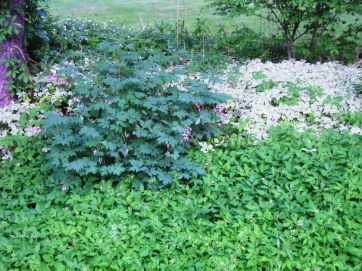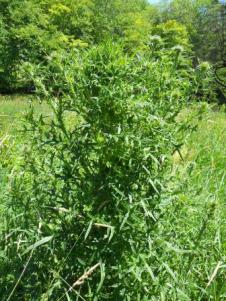What are your thoughts? Ponder away…
17 June 2014– An update on the status of wild chervil. Depending on where the plants are sited, most of them have flowered by now and are setting seed. We’re at the point, in central Vermont, where those seeds are now likely viable. Or at least the risk of that is very real.
If you were unable to prevent the chervil from flowering, there is still something you can do to break that heavy seed rain. The seeds hang on for about another month yet as the plant dries out.
Theoretically, you can collect those seed heads and save yourself a lot of work or frustration next year. Don’t try to do this everywhere, but if there are places with only a few colonizing chervil plants, definitely act on them. The idea is to keep an infestation confined to a few hot spots rather than having it all over the place.
Don’t worry about pulling the plant – it should die off now that it has seeded- but do be pro-active and gather up those seed heads in a bucket or bag. And destroy them.
Once the seeds start to shake loose, however, stay out of wild chervil infestations; you’ll only be helping the plant spread to new locations if you get the seeds all over you and your equipment. Chervil seeds, black when dried out, stick to almost everything so it’s best to stay out of areas where you can see the old dry stalks at the end of summer. And be aware that the soil likely contains viable seeds, in great numbers.
31 October 2013– Working the shrub invaders for a couple more weeks. Big differences to be seen between treatments for common versus glossy buckthorn – notes will be available on the Exchange page. Take care of that soil – improvements now have huge impacts in the spring.
9 August 2013– A big THANK YOU to all for your interest in controlling wild parsnip, the “danger plant” with a real and present impact on safe access to our productive lands and recreations areas. I pulled over 37,000 wild parsnip these last couple months, and I know that translates into at least 96 acres of land protected or under intensive management. There is NO state plan to deal with these ever-larger infestations, but I will continue to advocate for that. Also great to see landowners cooperating to address early infestations together without stressing over property boundaries. Thank you again! I think I’ll move on to some other species now…
26 June 2013– Time once again for the annual warning on wild parsnip. Photo-activated sap and scars that last a year. Not to be messed with. There’s a photo down below that I posted in 2011 – you can click on it and zoom for an up-close look. And you can always send a photo my way if you need a positive identification. By the way, the plants in the site banner above are giant hogweed, a little “gone by” since the photo was taken in September. But the instructive take-away is that parsnip and hogweed grow in dense patches, no surprise at all since they drop thousands of seeds in their immediate shadow. You may see them in long lines along a roadside or a ditch or even at recreation fields. If the soccer ball goes into the parsnip, don’t go in after it. Wait till maybe October!
5 July 2012– Attention out there, hear ye, hear ye… “seed rain” has begun for many of the heavy seeding invasives. I have not tracked down any garlic mustard for reference, but wild chervil is definitely dropping seeds. What this means is that the seeds have dried and are raining down onto the ground or sticking to clothes, shoes, vehicles, and whatever else they come in contact with. Chervil in particular seem to be perfectly adapted for spreading in this fashion. Do whatever you need to do to prevent the transport of seeds into un-infested areas – PLEASE! And if you attempt to collect the seeds onto a tarp or into a bucket, certainly do change out of your shoes, wash out your boots, shake out your hair, and inspect your gloves, before you leave the site. Tools as well…. again, chervil seeds seem to stick to everything. A little prevention can serve us well here.
13 May 2012– Goutweed (or bishop’s weed) is a hot topic this spring, judging by the questions that I receive. It was sold in the past in its variegated form, but is known to revert back to the more aggressive all-green variety. The photo illustrates the manner in which these variegated plants jumped the wall and escaped cultivation, now spreading vegetatively along a drainage. Very hard to control at this point, by any method.
23 July 2011 -Ran into this character today. Not literally, but I wouldn’t want to play night frisbee in this field. Meet bull thistle, and yes, this plant was taller than me. The stalk was easily 5 inches wide.
Bull thistle can be pulled out (I’ve done it without gloves, but I’d go with the gloves, and even perhaps someone else’s hands). They will gradually take over areas, so removal is a good idea. Lay them someplace to dry out, and keep those seed cones contained.
23 July 2011– We’re seeing the full splendor of wild parsnip now as it flowers and forms large seed heads. Avoid contact with this plant, particularly the sap.
And especially on sunny days! It will leave you with quite the rash. You’ll find it roadside and in many fields that are not maintained or mowed.
14 July 2011 – Saw my first jewelweed in flower – great color. They are natives, but yes, quite invasive….although controllable. Just push them back a bit by uprooting now if you want to hold them out of key areas. I’ll have some thoughts on safety tomorrow.
Folks, please be aware of wild parsnip –
It is on a tear this year….I’ve heard of four people so far getting this on their skin and suffering severely as a result. The sap is photo-activated, but don’t take any chances. I believe the plants are just beginning to flower, so if you see yellow flowers on a plant about 4-5 feet tall, avoid all contact and keep children out of the area.
 This is a black swallow-wort vine emerging in mid-May. They have begun flowering by now, and will begin forming their seed pods soon. Those seed pods release a lot of wind-borne seeds, so pull these vines now (and probably once more) if you want to prevent that airborne spreading.
This is a black swallow-wort vine emerging in mid-May. They have begun flowering by now, and will begin forming their seed pods soon. Those seed pods release a lot of wind-borne seeds, so pull these vines now (and probably once more) if you want to prevent that airborne spreading.





By now, May 19th, most if not all of the non-natives have emerged and some are even flowering. The knotweed is several feet tall, and I noticed black swallow-wort vines for the first time today. Seems early for them, but then everything is early this year…. no frost in sight to knock things down one more time. Even the ash leaves are out…wow!
Happy Summer!
And a word of caution…. I posted a photo of wild parsnip on my Comments page, check it out if you are unsure of what this plant looks like. At about 4 feet tall with sizable yellow flowers, wild parsnip is hard to miss, but blunder into it by accident and you’ll pay the price. I’ve seen loads of wild parsnip this year… it is non-native to our area but the white-flowered cow parsnip is actually a native. Both of these plants will do serious burn damage to your skin if the sap gets on your body. Sunlight amplifies the damage, so steer clear of the parsnips. Send me a photo if you have questions…. there are a couple more look-alikes that I could help identify.
Does the wild parsnip have an aroma like something dead that is rotting?
Hi Cathy,
Thanks for the question. The only plant that I would describe as “something dead or rotting” would be a large patch of black swallow-wort vines. They smother like kudzu and if you come across a field full of it you won’t like the smell…. kind of like rotting fruit. That’s a borrowed description, but I agree with it. Hopefully you don’t have black swallow-wort; the vines are deep green with the milkweed-style seed pod. I doubt you’ll be able to confirm the swallow-wort this time of year, unless you can find the exploded pods hanging from dried out vines.
Wild parsnip has a carroty aroma, especially the root. I don’t even try to sniff the leaves or stem – don’t want to risk a sap encounter. I have worked large patches of wild parsnip, many acres, and what sticks in my mind is the constant buzzing of honeybees, but no repulsive smell. Feel free to send a plant photo if you need a confirmation.
Thanks again, Mike
18 July: So as I was gearing up the other day for a full session of wild parsnip control, I realized just how much time and energy goes into safety prep. I saw another fella out doing the weed-whacker and he was full-geared as well…. good for him. Tempting to cut corners when it’s in the upper 80s.
But, the thought goes like this…. better to lose time to safety, than to lose even more time to injury.
Be safe,
Mike
8 November: If you’re out on a walkabout in the next couple weeks, think about bringing a little blueberry bucket along. When you come across a burning bush or a barberry with dozens of berries still hanging on the branches, go ahead and collect them all up. No sense letting them hit the ground to create another generation of invaders. Sure it’s getting late in the season, but you may still find some shrubs with the berries still on the branches. And you can flag the location if you don’t have time to uproot the shrub right now. If you do want to try pulling a smaller barberry, don’t sweat the spikes – just use good leather gloves, and grab the stems all together in a downward motion. Once you grasp the stems(s) don’t let your hand slide upward. That’s the trick to avoiding a poke from those long thin spike thorns. Smaller shrubs come out without too much trouble; if pulling in one direction doesn’t work, rotate around to another side and pull again. Check for ticks when you’re done for the day, even this late in the year!
Saw greater celandine and wild chervil in the yard edges today. Not good… they are very green, not too tall yet, and they actually pulled pretty easily. While this might be a good chance to go after them due to the relatively soft soil, I wouldn’t create too much work for yourself. Let the next freeze knock them down, hopefully. That may not work everywhere, and I do not actually know how low a temperature these plants can tolerate. Your best bet at this point is to note locations, before other things green up the space. WIth that information, you can plan your control work for April / May.
I brushed away the leaves around some dried Japanese knotweed stalks last weekend and sure enough, the new shoots are pushing up. Depends on how much sun a site is getting, but I’ll call April 20 / 21 the dates that I first observed them emerging. Here we go… one more good freeze would be helpful, right there in early May. Let’s hope.